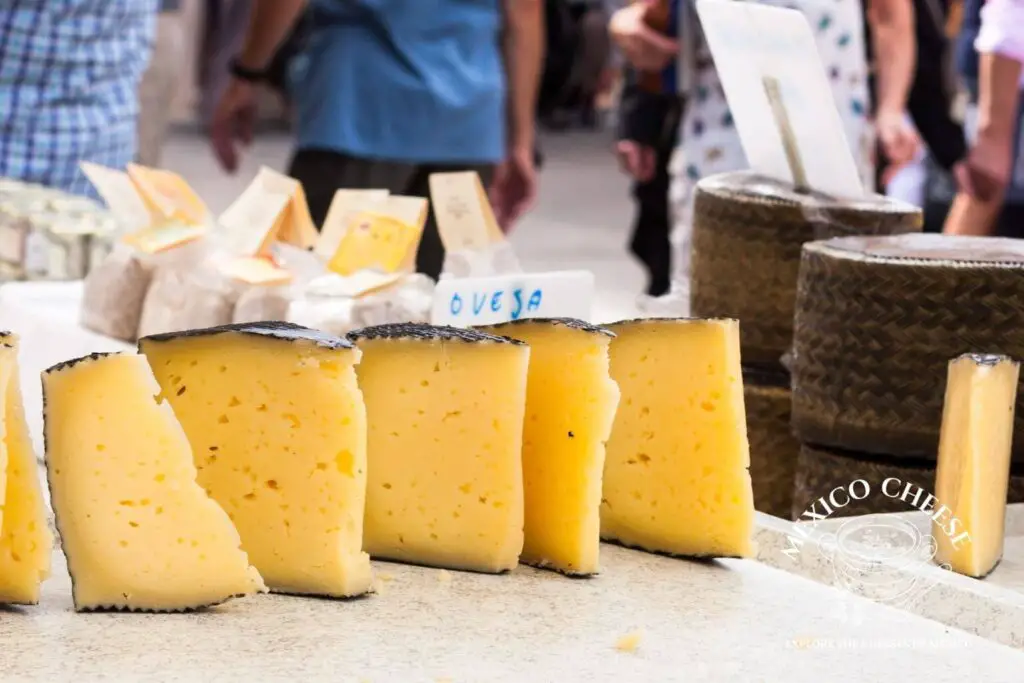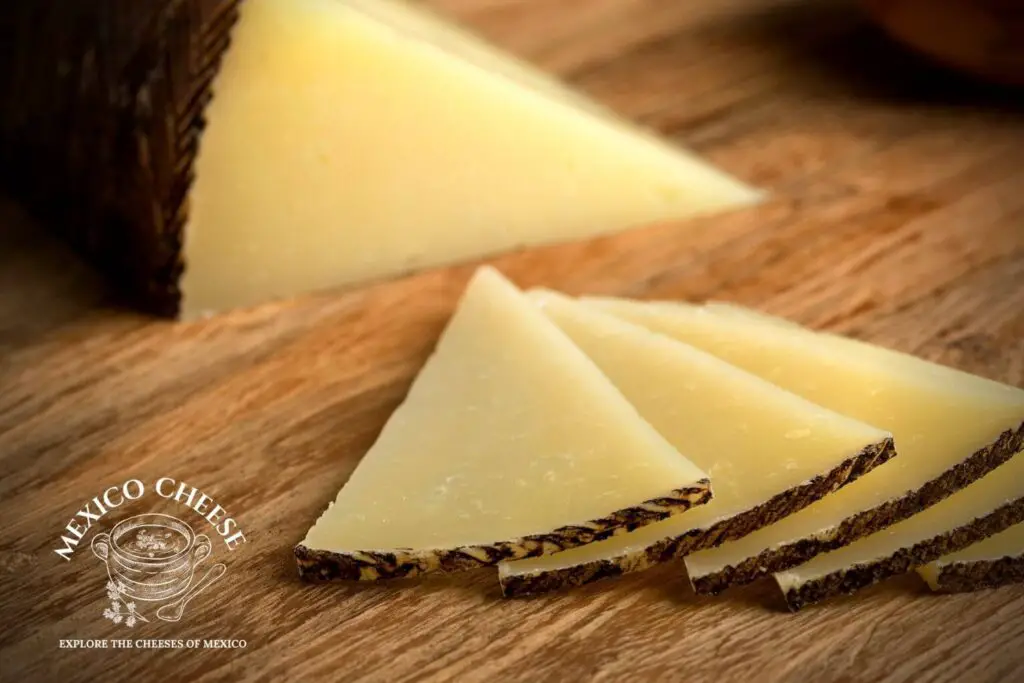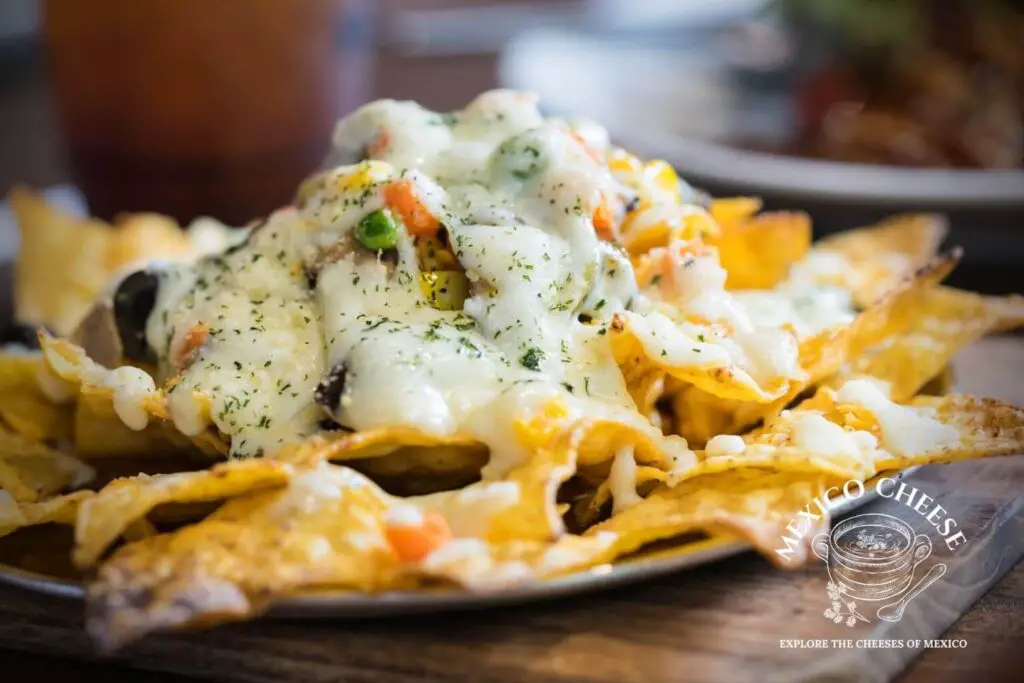Mexican Manchego vs Spanish Manchego – What’s in a name?
Contents
If you have ever perused the international cheese section of your supermarket you have undoubtedly come across cheese labeled “manchego”. You may even have noticed two distinctly different styles of cheese both called “manchego”. One is a hard, ivory-white cheese with a distinctive rind. The other is a buttery yellow cheese that is soft and creamy. Have you ever wondered how these two cheeses came to share a name?
Let’s take a closer look at the origin of these two important cheeses, the similarities, the differences and the best uses for each. We will answer the question Mexican Manchego vs Spanish Manchego once and for all.
What is Manchego cheese?
Manchego (pronounced man-CHAY-go) is an uncooked, pressed curd cheese that originated in Spain. The cheese has a hard rind that is easily distinguished by the zig-zag, herringbone design imprinted by the mould in which it is aged.

The cheese takes its name from both the region of La Mancha and the manchega breed of sheep that produce the particularly rich, fatty milk used to make authentic Manchego cheese. To make Manchego cheese, the sheep’s milk is encouraged to curdle with the addition of rennet and the resulting curds are gently cut and pressed in round moulds. The rounds are then brined and allowed to age naturally in the caves found in the region.
Manchego fresco is ready to consume after just two weeks but the rounds meant to age longer are brushed with olive oil to develop a hard rind and allowed to cure for anywhere from one month to two years.
The recorded history of Spanish Manchego cheese dates back to the Bronze Age. Archeologists have found evidence of cheese production by shepherds in the La Mancha region that goes back well before the birth of Christ, approximately 3000 B.C. – 1200 B.C. Manchego is currently Spain’s most popular cheese both in terms of domestic consumption and the number of tons exported annually.
Today, true Spanish Manchego is protected by Spanish Denomination of Origen (DOO) and European Protected Designation of Origin (PDO) and its production must meet some very exacting criteria.
What are the varieties of Spanish Queso Manchego?
Manchego Fresco
Manchego fresco is the youngest type of Manchego cheese. It will have been allowed to age in the natural caves in the La Mancha region for just two weeks before it is packaged for sale. The cheese still has good moisture content and is solid but soft and buttery tasting. The texture is smooth and the color is bone white. Its rind is just starting to develop and is still thin and light in color. As it perishes quickly, it is unlikely that you will find this Manchego fresco for sale outside of the region much less the country.
Manchego Semicurado
Manchego semicurado is cheese that has been left to age a bit longer, from three weeks but not longer than three months, before being packaged for consumers. The cheese has lost more of its moisture content and is becoming more crumbly. The color may change to from white to ivory. The rind is beginning to truly harden and the flavors becoming intensified. After three months, Manchego cheese left to mature in the caves is considered curado.

Manchego Curado
Manchego curado has been aged between three and six months in the caves of La Mancha and at this point is still considered only halfway cured. The cheese is hard and crumbly with a mildly nutty flavor and a buttery-smooth, creamy mouth-feel. Manchego curado is a versatile cheese and one of the most commonly used in Spanish homes and restaurants. This is a very common cheese to find all over Spain and exported to markets all over the world including Mexico and the United States.

Manchego Viejo
Manchego viejo must be aged for over a year and up to two years. At this point, the cheese is fully cured and has a solid consistency and is very crumbly. The color has intensified to a toasted yellow. The rind is now fully-developed, thick, hard and dark in color. The nutty, tangy flavor and earthy aroma have intensified due to time and the loss of moisture. This is the most expensive of the types of Manchego cheese and the most treasured.

Today, Spanish Manchego is made by artisanal producers as well as in large industrial factories. While both produce their own version of Spain’s iconic cheese, there is one notable difference for modern consumers.
Mass-produced, industrialized Manchego is made with pasteurized milk. This makes the cheese suitable for export to be enjoyed by cheese enthusiasts all over the world. Look for “Queso Manchego, Denominación de Origen” on the label.
Artisan producers of traditional Manchego continue to use raw sheep’s milk to this day, preserving the cultural tradition. As such, cheese labeled “Queso Manchego Artesano, DO” is available to be enjoyed only by cheese lovers inside its country of origin.
Manchego vs Manchego – Claim to the name
In 1984, Spanish Manchego cheese received the official Spanish Denomination of Origin (DOO). To maintain this distinction and be able to use the prestigious seal of authenticity, Manchego cheese must be made with whole milk from indigenous manchega sheep and aged for at least two months in the natural caves in the provinces of Albacete, Ciudad Real, Cuenca, and Toledo, the arid, high plains region known as La Mancha.
Since 1984, cheese produced outside of this region or from another breed of sheep may only be labeled “manchego-style” or “imitation manchego”. How is it then that Mexico lays claim to a cheese with the same name? Manchego cheese has been made in Mexico since the late 1500s but only in the last few decades has the use of the name caused a stir in the Spanish cheesemaking community.
Is Mexican Manchego the same cheese as Spanish Manchego?
As we know, milk-producing livestock and cheesemaking traditions and techniques were introduced to the New World by Spaniards colonizing what is now Mexico. The country has no record of cheesemaking until the 16th century. When they arrived, the Spanish brought with them recipes for Manchego cheese that had been used for thousands of years.
Mexican Manchego has morphed over the centuries into a cheese that bears absolutely no resemblance to Queso Manchego from Spain. Today, the cheese is made from pasteurized cow’s milk. It is semi-firm, rindless and buttery-white in color. It has a fairly high moisture content and melts well when heated becoming gooey and stringy.

Mexican manchego is mass-produced and distributed all over Mexico. It can be found in rounds, wedges, sliced, cubed and shredded. It is a versatile cheese that can be used in tortas and tacos atop molletes and nachos and anytime a smooth, meltable cheese is called for.
Authentic Manchego cheese, imported from Spain, is also consumed in Mexico but used in a completely different way. Manchego viejo, curado and semicurado are all available in most grocery stores across Mexico but because of the importation, the offerings are relatively expensive.
The authentic Spanish Manchego available in Mexico is usually sliced thin and eaten on its own, included in a nice charcuterie assortment or as part of a dessert cheese course. Cheese enthusiasts presenting a tapas-style cocktail or dinner party will naturally reach for this cheese first.
As you can see, the two cheeses share a name but little else.
Protecting the name Manchego
For many years, a fight has been brewing about the use of the name Manchego as used in the labeling, marketing and promotion of cheeses produced in Mexico. In Europe, cheese can only be labeled “Queso Manchego” if it meets the exacting criteria detailed for the Protected Designation of Origin granted under the laws set by the European Commission.
The Denominación de Origen is awarded to help preserve traditional recipes and production techniques within a specified area and to prevent imitation products from entering the market. These location-based types of protection are known as Geographical Indications (GIs). This can be thought of as a “trademark” of sorts but for a region rather than an individual or a corporation.

Mexico has granted seventeen of its own regionally specific products the Denominación de Origen status. The most famous is inarguably Tequila but other DOO products in Mexico include Mezcal, Ambar de Chiapas, Talavera, Vanila de Papantla, Arroz de Morelos and Café Veracruz to name just a few.
Interestingly, while the majority of the products covered by DOO protection are food and beverage items, cheese and other dairy products are still missing from the list. It is only just recently that Mexico’s dairy industry has shown any interest in taking steps to preserve and protect its regional cheeses.
The United States, one of the most important markets for exported cheese from Europe, does not award or recognize any Geographic Indications for cheese. Cheese for importation must meet a variety of criteria, most having to do with health and safety issues.
Is Spanish Manchego better than Mexican Manchego?
In Spain, Manchego represents the highest levels of cheesemaking. Spanish cheese exporters wishing to protect their claim on the lucrative Manchego cheese market lament that Mexican manchego is damaging to the reputation of true Queso Manchego.

Across the Atlantic, Mexican Manchego cheese is pumped out in factories all over the country. It is made with pasteurized cow’s milk rather than the rich milk from manchega sheep. It can contain added flavors, colors and preservatives and is considered a common “everyday” commodity.

Mexican Manchego cheese is also a fraction of the price of its Spanish cousin. While the two cheeses are not alike in any way, neither in appearance, texture or taste, Spanish cheese exporters lament that the offer of inexpensive Mexican “manchego” is confusing to consumers who may select this cheese on price alone.
Mexico keeps its Manchego Cheese
The fight came to a head in 2018 during negotiations for a revised trade agreement between Mexico and the European Union which had not been updated since 2000. At the time, Mexico, seeking to diversify its exportation efforts to diffuse its dependence on the United States, already recognized and respected the names of 30 cheeses with DOO protection in European countries. The updated trade agreement sought to add an additional 27 items to the list and the right to the name “Manchego” was a sticking point in the deal.

The Spanish Brotherhood of Manchego Cheese and Spain’s Manchego Cheese Denomination of Origin Regulatory Commission Foundation, two organizations representing Spanish cheesemaking interests, adamantly maintained that there is only one product worthy of the protected name. Spanish Manchego now has to be certified to use the name.
The Mexican cheese producers, in turn, argued that if anyone is to blame for the migration of the name it is the Spanish themselves who came to colonize the New World in the 1500s bringing with them their cheesemaking recipes and the name Manchego.
The Spanish cheese lobbyists fought hard for the rights to the name but in a surprising turn of events, Mexico was ultimately granted permission to continue to use the name “Manchego”.

Mexican cheese producers could use the name Manchego on their labels as long as there was no attempt made in marketing, packaging or description to mislead consumers into thinking it was Spanish Manchego cheese. There must be no use of the Spanish flag nor intentional “signaling” by using its colors.
In short, modern Mexican cheese producers may use the name Manchego but they must promote the cheese on its own attributes and unique qualities.
In the end, the question of Mexican Manchego vs Spanish Manchego is a difficult one to answer. These are two cheeses with the same provenance that could not be less alike. One belongs melted on a toasted bolillo with refried black beans and pico de gallo. The other is at home on a toasted baguette with olive oil and jamon serrano.
Knowing the difference between the two will help you make the right decision when you are going to purchase a Queso Manchego to use in your dishes.
Provecho!

1 thought on “Mexican Manchego vs Spanish Manchego”